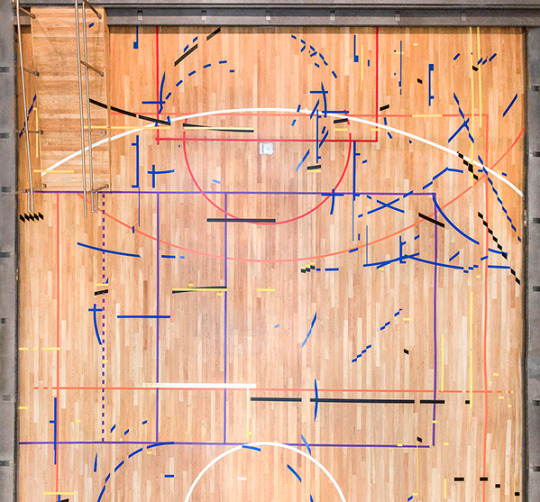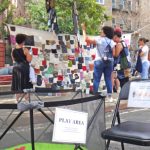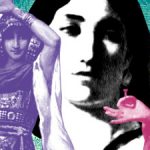Conversations | Changing the World With Your Art, While Maintaining a Work-Life Balance
Find out how to stay focused and keep your mind, art, and heart inspired with a few tips from the IAP Interview Archives.
Below you’ll find top tips and advice for immigrant artists and creatives collected from conversations featured in IAP Newsletters across the years. Whether you’re telling your personal story, looking for a residency, or balancing a 9-to-5 job with your artistic practice, read on to learn more about the fine art of wearing multiple hats in the art world. For the full conversations, click on the interviewees’ names below.
NYFA: What advice would you give to artists who are looking to share their personal story in the hopes of inspiring large social change but who do not know where to start?
Ambika Samarthya-Howard: I think the hardest part of sharing your personal story is that when people reject it, it feels like they are rejecting you. This is true if you are a writer or a video producer, or a painter. Art is always hard because it’s a reflection of your identity in so many ways, but it’s even harder when it’s a personal story that’s already fraught with vulnerability, like stories of trauma.
My advice is to first step back and ask yourself if you want/need to tell this story. I’ve often found telling my story to be key to personal growth and very cathartic and so whether it’s accepted in a film festival or publication, I was happy to tell it. Second, do you want to put this story out there? Artists can have personal projects that they don’t share and I think it’s worth asking, especially with sensitive subject matters, if it makes sense to put this out into the world. How would a public critique or rude comment on YouTube make you feel? Lastly, connecting to community and other artists can often make this process easier and help through the journey of not only producing the work, but also the much harder process of sharing it and finding the right channels for distribution.
Martita Abril: I found it was critical to be comfortable with myself and my own style and to embrace and engage my fellow immigrant artists like the community embraced me.
Techung: Well, immigrant artists naturally face more challenges, but they should never give up on their art and instead work toward finding possibilities. There are a lot of kind people out there—organizations such as NYFA and others who will support, give feedback, and guidance—but the drive should come from the artists themselves. It takes time and energy to succeed and one must not feel shy or discouraged to ask for help. Keep your mind, heart, and art inspired.
Angélica Dass: For me, the role of an artist is to start a conversation. Because, in the end, I really believe that I can’t change the world; the only person that I can change is myself. But if we talk more about these issues that you feel are not right outside (and as an artist you are able to put these inflections in the making of art), maybe other people can decide they want to change themselves. So that is why I see the role of the artist as someone that uses something (photography, archive, images, etc.) to generate empathy and propose a discussion that can have a direct impact on our collective future.
I always have the same advice for my students and it is: “Be honest!” It looks like something very basic, but really, be honest! You know it when you are doing something that is not right, not coherent, in a work of art. This is something that I miss in the art world, sometimes. Maybe we can be too critical and too political in a piece, but the truth is that we are just showing one side. My other advice is to give back. Give back to the community that you’re working with and try to be coherent and respectful of them.
Sébastien Sanz de Santamaría: When artists are applying for opportunities, they should ask these four questions: What do I need to advance my creative practice? Does this opportunity (grant, residency, workshop, etc.) provide the resources and means for me to advance my practice? Do I have all the requirements necessary to apply? Have I reviewed all the details of the program entirely? I think to be successful you must select the right opportunity at the right time. After that, I think perseverance is very important. Normally, one successful experience takes you to the next one, in a process that is connected with your artwork.
Ronny Quevedo: If there is something you need help with, reach out to someone that can help you. We shouldn’t be ashamed of our unfamiliarity with something. For example, I didn’t know how to develop a budget for a very long time. Try not to hide what you think you are not good at, instead be more proactive about facing what challenges you.

NYFA: What are your tips for balancing a job with an artistic practice?
Gisela Insuaste: I think of them [my job and artistic practice] as part of my identity as a human being (and engaged in activities that are important to me), and avoid thinking of these as separate, vying for my time and energy. I see them in collaboration.
Ideally, the administrative work connects, informs, or inspires my artistic practice and vice-versa, but most importantly, aligns with my values. Actually, that’s the case for all activities, relationships, etc. in my life. I’d like to say that once your values are aligned, then everything is perfect! But that’s not the case—it’s also about time management and prioritizing the work, making adjustments, always. Sometimes, administrative work will require more time, while a creative project takes back seat. Shifting gears for a 35-mile bike ride in the hills is just as important if your body and mind need to be outdoors.
A good practice for me is to take moments to play and socialize during intense work, either in the office or studio, with friends or colleagues. If need be, set parameters with people or spaces to manage time—decide what’s important to get the work done and surround yourself with what you think you’ll need. Assess where you’re at with your projects/personal well-being. Sleep, eat well. Go outdoors for a walk and get some Vitamin D!
Marco Antonio Castro: I have been active in the New York arts community since my arrival in 2005. I co-founded and curated MoD (Monitor Digital), the first Interactive Art Festival in Guadalajara, Mexico. We brokered partnerships in the public and private sector to give new audiences an access point to explore digital art and performances. From 2007 to 2013, I guided the vision, curatorial strategies, fundraising, and assessment for the annual festival, while tapping the diverse arts community that thrives in New York. MoD’s public programs, workshops, performances, and artists expanded the festival’s reach to ultimately serve as a pipeline for international artists to connect and collaborate across borders. The festival has helped me understand the process and care needed to reach new audiences and how to make a digital exhibition as inviting as possible without lowering the quality of the content. This has helped me in my practice to make sure I know how to talk about my projects in different ways, to make them understandable by different audiences.
Catherine Yu: For an art form so bound to structure and plot, remember with relief that life works differently from art. Life often goes off-script. For those who feel daunted by the unknown, allow me to quote the great poet Rainer Maria Rilke: “The future enters into us in this way in order to transform itself in us long before it happens.”
Leeza Ahmady: One of the skills I’ve managed to develop is to keep the insight that the art world has many parts and that each part plays an important role at the forefront of my mind. I see it as an ecology, a landscape. Because of this perspective, I’ve been able to include and engage with all spectrums of the art scene: the nonprofit and for-profit museums and galleries, academic institutions, art biennials and festivals, smaller arts organizations with similar missions, community organizations, and artistic collectives as well as auction houses and art fairs. I have achieved this by being conscious of each entity’s mission and by creating and envisioning programs that appeal and address the needs of all these varying operating sectors while keeping the empowerment and promotion of artists at the very top of ACAW’s priority. It’s all about making practical, conceptual use of what resources are already there and sharing the spotlight without being invasive of any one’s territory.
– Interview Conducted by Alicia Ehni, Program Officer at NYFA Learning
This interview is part of the ConEdison Immigrant Artist Program Newsletter #120. Subscribe to this free monthly e-mail for artist’s features, opportunities, and events.
Images from Top: Angélica Dass, Yo Soy Somos, Courtesy the artist; Ronny Quevedo, no hay medio tempo: there is no halftime (detail), 2017, Queens Museum, Photo Credit: Hai Zhang






